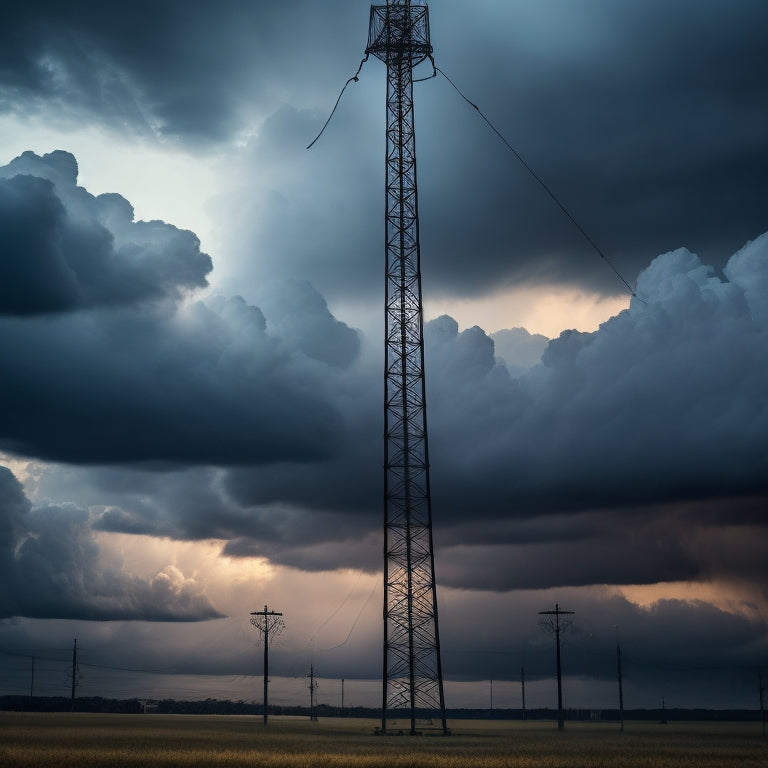
Boost Telescopic Mast Performance in Any Weather
Share
To enhance telescopic mast performance in any weather, it's vital to implement specialized maintenance and weatherproofing techniques. Extreme temperatures can compromise mast performance and lifespan if not addressed properly. Applying antifreeze kits in freezing conditions and lubricants in warm weather is essential. Regular inspections and routine maintenance can help spot potential issues early, ensuring peak performance and reliability. By following best practices and adjusting maintenance schedules according to seasonal changes, telescopic mast systems can be optimized for uninterrupted operation. By understanding these essential factors, mast performance can be maximized, even in the most challenging environmental conditions.
Key Takeaways
• Apply antifreeze kits in freezing conditions and lubricants in warm weather to ensure smooth mast operation and prevent damage.
• Conduct routine inspections and implement weatherproofing techniques to block water and moisture, safeguarding your mast investment.
• Establish a weather-resistant maintenance schedule and adjust routines based on seasonal changes to optimize mast performance year-round.
• Focus on weep holes in mast collars when applying antifreeze, and flush out all antifreeze before applying lubricant in warmer climates.
• Implement seasonal adjustments and apply specialized kits to mitigate the effects of extreme weather conditions, ensuring reliable operations always.
Preparing for Extreme Weather
To maximize performance of Will-Burt pneumatic telescopic masts in extreme weather conditions, it is important to prepare the mast for freezing and warm weather by using an alternative antifreeze kit. This kit enhances mast performance during extreme weather conditions, ensuring best functionality.
Weatherproofing techniques, such as applying antifreeze to weep holes in mast collars during freezing conditions, are essential for mast maintenance. Conversely, warm weather tips involve flushing out all antifreeze before applying lubricant. Failure to do so compromises mast performance.
Protecting Your Mast Investment
Proper upkeep and safeguarding of a Will-Burt pneumatic telescopic mast are vital to prolonging its lifespan and guaranteeing peak performance in extreme weather conditions.
To safeguard your mast investment, follow these essential tips:
-
Routine inspections: Conduct regular checks to spot possible issues before they escalate into major problems.
-
Weatherproofing techniques: Implement efficient weatherproofing measures, like sealing any openings or fissures, to block water and moisture from entering the mast.
-
Correct lubrication: Apply the appropriate lubricants to moving components to maintain smooth operation and deter corrosion.
Antifreeze Application Best Practices
In addition to routine inspections, weatherproofing techniques, and correct lubrication, applying antifreeze to a Will-Burt pneumatic telescopic mast is a vital step in maximizing its performance and lifespan in extreme weather conditions. Proper antifreeze application is crucial to prevent freezing and corrosion, ensuring best mast operation.
When applying antifreeze, follow the manufacturer's instructions and focus on the weep holes in the mast collars. It is essential to flush out all antifreeze before applying lubricant in warmer climates to maintain mast performance. Failure to do so can compromise mast operation.
For detailed instructions, refer to the downloadable product manual. By following these antifreeze application best practices, you can optimize your Will-Burt pneumatic telescopic mast performs at its best in any weather condition.
Optimizing Mast Performance Year-Round
Throughout the year, Will-Burt pneumatic telescopic masts require consistent upkeep and adjustment to achieve peak efficiency in various weather conditions. To maximize mast performance year-round, it is crucial to establish a weather-resistant maintenance schedule. This involves adjusting to seasonal changes by using antifreeze kits in freezing conditions and lubricants in warm weather.
Here are key considerations for year-round enhancement:
-
Seasonal adjustment: Modify maintenance routines based on seasonal changes to ensure top performance.
-
Weather-resistant maintenance: Conduct regular checks and maintenance to prevent weather-related damage.
-
Peak performance: Routinely inspect and maintain masts to achieve the best performance in any weather condition.
Ensuring Reliable Operations Always
To secure reliable operations always, Will-Burt pneumatic telescopic masts require a combination of regular maintenance, seasonal adjustments, and the application of specialized kits to mitigate the effects of extreme weather conditions.
By implementing these measures, users can maximize efficiency and guarantee uninterrupted performance. Weatherproofing techniques, such as the application of antifreeze kits, play an essential role in maintaining mast functionality in freezing and warm weather conditions. Failure to apply these kits or flush out antifreeze before applying lubricant can compromise mast performance.
Frequently Asked Questions
Can I Use the Antifreeze Kit on Non-Will-Burt Masts?
'When considering the antifreeze kit for non-Will-Burt masts, compatibility concerns arise, and performance comparisons are vital. Guarantee proper fit and function to avoid compromised mast performance, and consult with a technical expert or manufacturer for guidance.'
How Often Should I Inspect My Mast for Weather Damage?
Regular mast inspections are essential to guarantee peak performance and longevity, as hidden weather damage can lead to catastrophic failures; schedule routine checks to identify vulnerabilities and maintain weather resistance through diligent mast maintenance.
Are There Any Alternative Lubricants for Warm Weather?
When selecting alternative lubricants for warm weather, verify compatibility with your mast's materials and best application techniques to prevent compromise. Consult the product manual or contact Will-Burt's customer service for guidance on suitable lubricants and application best practices.
Can I Reuse Antifreeze From Previous Seasons?
"Prudent maintenance dictates that antifreeze should not be reused across seasons, as its effectiveness may degrade, and improper disposal can contaminate the system, compromising mast performance; instead, dispose of used antifreeze responsibly and apply fresh solution each season."
What Is the Recommended Storage Temperature for the Antifreeze Kit?
For best antifreeze effectiveness, store the kit at room temperature (between 60°F to 80°F) to maintain its viscosity and prevent degradation, ensuring reliable performance during extreme weather conditions.
Related Posts
-

What's the Secret to Organizing Digital Clutter?
You're tired of feeling overwhelmed by digital mess, wasting time searching for lost files and drowning in a sea of d...
-

Transform Your Space: 5 Online Courses to Help
Ready to transform your space from cluttered to calm? Start with mastering home organization fundamentals, like declu...
-

Master Home Organization With These 5 Online Courses
You're about to gain control over your living space with an all-inclusive education in home organization, courtesy of...


